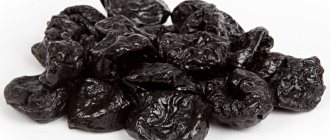Broccoli for gastritis
A small study of 50 people found that just 80 grams of broccoli a day could protect your stomach from ulcers, gastritis and even cancer. The medicinal property of broccoli lies in the sulforaphane it contains, a potential antibiotic against Helicobacter pylori.
It is not advisable to eat broccoli raw if you have gastritis. As an alternative, a stewed, boiled or baked product is offered. This is due to the fact that broccoli contains a lot of fiber.
It is not advisable to eat broccoli raw if you have gastritis.
It aggravates the course of the disease and can lead to severe pain and other consequences. Processed vegetables retain almost the same amount of vitamins as raw vegetables, and dietary fiber is transformed and does not irritate the mucous membrane of the stomach and intestines.
The inflorescences and stems of broccoli are eaten. Due to the fibrous structure, the stem takes longer to cook. Inflorescences dipped in boiling water will be ready for use in 5-7 minutes. It will take 15 minutes to simmer the vegetable until tender. The frozen product is left for several hours at room temperature and is not defrosted in a microwave oven.
A wide variety of broccoli dishes are prepared. However, with different forms of the disease - with high acidity, low acidity, it is allowed to eat different amounts of cabbage and in different forms. Broccoli for gastritis with high acidity is also undesirable.
How to properly cook broccoli for gastritis
Steamed broccoli is the best option. When cooked, the taste of broccoli remains soft and neutral. Easily combines with any types of other vegetables, cereals and meats. They do not cook for long: to get soft melting pulp, boil for 12 minutes, al dente - 5-7 minutes.
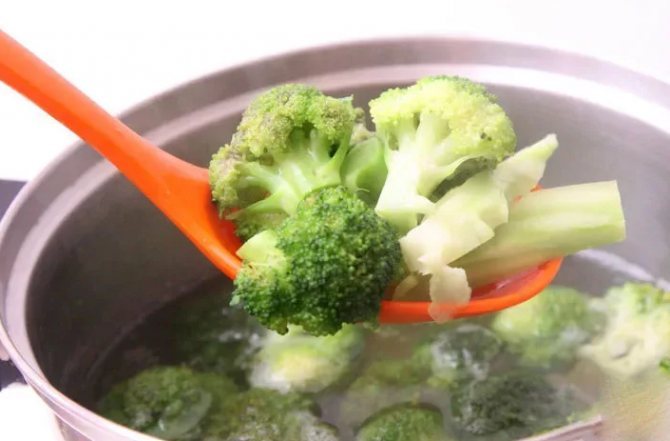
A wide variety of broccoli dishes are prepared.
You can also boil broccoli in water, but broccoli boiled in water is slightly worse in composition, as it loses water-soluble vitamins. It should be cooked for a minimum time of 15–20 minutes. The taste is more blurred and watery.
Broccoli can be baked for gastritis. Broccoli is usually baked as part of a casserole, since the vegetable itself has too weak a taste. With this processing, the calorie content of the product increases, as it loses moisture.
Roasting broccoli is allowed only during the remission stage. The inflorescences are first boiled and fried in egg or batter, only to change the taste. In acute and severe chronic gastritis, frying is excluded. Even to boiled cabbage, oil is added with great care.
Broccoli juice for gastritis
In addition to fresh broccoli, freshly squeezed cabbage juice is used for gastritis. To prepare broccoli juice, the cabbage inflorescences are dipped in boiling water for a couple of minutes, allowed to cool slightly, placed in a juicer or crushed in a blender, squeezing out the juice.
Drink broccoli juice before meals at the first symptoms of gastritis, when the disease is just developing. Broccoli contains sulforaphane, which acts as an “antibiotic” against harmful bacteria and stops the inflammatory process.
Cooking methods
Pickled
Sauerkraut will be useful for gastritis when the disease is in remission, because it promotes:
- improving motility and the entire intestinal microflora;
- eliminating constipation;
- increasing immunity;
- eliminating inflammation of the gastric mucosa.
You can eat sauerkraut in small quantities without exacerbation of gastritis with low acidity. It promotes the production of gastric juice.
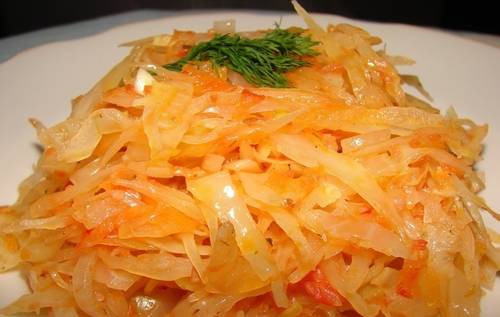
Stewed
Stewed cabbage for gastritis will be a positive product on the menu. After all, during cooking, the vegetable retains many beneficial properties that are easily digested. This dish has several advantages:
- helps relieve inflammation of the mucous membrane;
- helps improve digestion;
- helps reduce pain.
Cabbage juice
This drink is widely used in traditional medicine for gastritis. It retains all the beneficial properties of a fresh vegetable, but at the same time it does not contain coarse fibers that cause irritation to the mucous membrane. Its advantages are that the juice:
- heals damaged areas;
- helps relieve heartburn and nausea during acute gastritis;
- removes toxins and waste from the intestines.
You should start using it with a small amount, because it can cause rumbling in the stomach and discomfort.
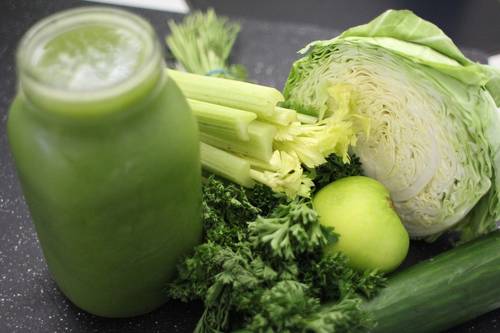
Cabbage is a very healthy product, so you shouldn’t limit yourself to its consumption. You just need to approach preparation wisely and follow all the advice. Also, before including this product on the menu, do not forget to consult your doctor so that you do not experience complications.
Is it possible to eat broccoli for gastritis?
Eating raw broccoli for gastritis is unacceptable. The coarse fiber contained in broccoli irritates the intestinal walls of a patient with gastritis and ultimately leads to severe heartburn, bloating, nausea and vomiting. Therefore, it is necessary to smooth out the negative aspects that are associated with eating broccoli for all types of gastritis.
But broccoli, if properly cooked, can be baked, boiled or stewed. This type of cabbage is contraindicated only in cases of increased acidity and individual intolerance. Broccoli is a good secretion stimulant, so in small quantities as an addition to the main dish, this type of cabbage is useful for low acidity and gastritis.
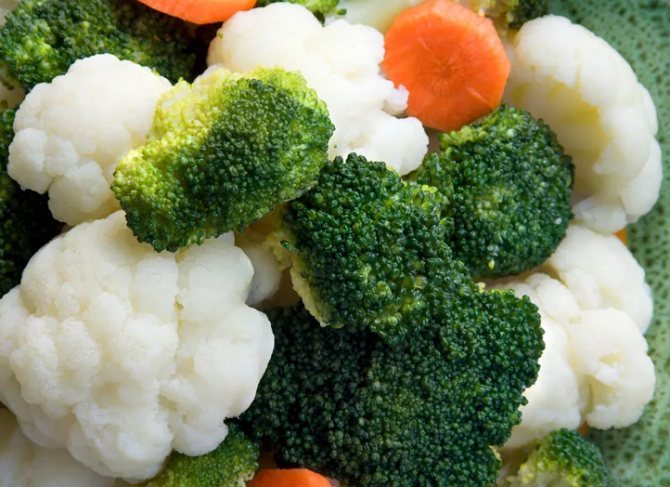
With low acidity accompanying gastritis, broccoli consumption is necessary
Some people are concerned about the question: is it possible to eat stewed broccoli if you have gastritis? No, it’s better not to, because during the cooking process, acids are released into the liquid part of the dish, which will lead to an exacerbation of the disease.
Is it possible to eat broccoli with low acidity?
With low acidity that accompanies gastritis, eating broccoli is necessary. Smoothies, puree soups and main courses are prepared from it. It goes well with other vegetables, meat and fish. Regular consumption of broccoli with low acidity helps normalize the level of digestive enzymes. It acts as a stimulator of gastric secretion and relieves irritation from the mucous membrane. The daily intake of broccoli with low acidity is 200-220 grams.
White cabbage
Many people suffering from diseases of the digestive system often wonder if they can eat this vegetable. Experts do not recommend eating fresh cabbage if you have gastritis. It causes mechanical damage to the inflamed mucosa and increases pain.
However, this is not a reason to completely abandon this type of vegetable. For gastritis, stewed cabbage is indicated, which improves intestinal motility and saturates the body with useful vitamins and microelements. It is rich in sulfur, magnesium, potassium and iodine. Eating a small amount of sauerkraut will bring no less benefit for hypoacid gastritis. This product contains many pectins, which have anti-inflammatory properties.
Broccoli for gastritis with high acidity
If you have high acidity, broccoli should be eaten in very moderate quantities. It is steamed, with a minimum amount of oil and with the addition of other vegetables that reduce the level of the enzyme involved in the digestion process. The daily intake of broccoli in this case should not exceed 30-40 grams. It is not recommended to eat it before bed due to the presence of a number of components that provoke the formation of gases in the intestines.
Broccoli and cauliflower soup for high acidity
For high acidity, broccoli and cauliflower soup is beneficial. A weak broth is made from 300 grams of veal. Then the meat is taken out, and the prepared 100 grams of bulgur are placed in the pan.
After 10 minutes, a small carrot, an onion and 300 grams of broccoli and cauliflower are sent there. The soup is simmered over low heat for 15 minutes. At the very end, add the veal, disassembled into fibers, and after turning off, season the soup with a spoon of vegetable oil.
Italian-style cutlets with high acidity
Boil 200 grams of broccoli, mix with 1 egg and grind in a blender. Then add 600 grams of minced meat, chopped onion, salt, pepper and a tablespoon of low-fat sour cream to the mixture. Cutlets are formed from the mass and steamed.
Another option for preparing cutlets with the addition of broccoli: mix all the ingredients except cabbage, and put a whole boiled inflorescence inside each cutlet.
Nutrition for stomach ulcers: will you have to forget about milk?
It is necessary to approach therapeutic nutrition for stomach ulcers especially responsibly - after all, the exacerbation of a peptic ulcer, or vice versa - its relief, directly depends on what you ate an hour earlier. Diet for stomach ulcers should include foods that restore the gastric mucosa. Do you think such people don't exist? You are wrong!
- Broccoli, cauliflower and kale are essential foods in the diet for stomach ulcers. These vegetables contain a unique substance that can neutralize the action of the bacteria that causes stomach ulcers.
Diet for peptic ulcers: yogurt, honey and cabbage
Before talking about nutrition for stomach ulcers, it is necessary to dispel several myths associated with the occurrence and course of this disease.
For a long time it was generally accepted that stomach ulcers occur primarily due to poor diet, alcohol abuse, frequent stress and depression, smoking and excessive love of coffee. But medical studies have shown that we owe 90% of stomach ulcers to the activity of the bacterium Helicobacter Pylori. Therefore, the most adequate treatment for acute attacks of peptic ulcer is the use of antibiotics. But at the same time, special nutrition (and often a special therapeutic diet table 1, which is prescribed by doctors) is especially important! After all, antibiotics kill not only harmful bacteria, but also those that a person needs to maintain health and strong immunity.
However, the bacteria that cause stomach ulcers are affected not only by antibiotics, but also by certain foods. And it is often recommended to enrich the diet for stomach ulcers with products that have bactericidal properties, including, for example, honey. The antibacterial properties of honey have given it an excellent reputation.
Honey is well known in folk medicine as a remedy against stomach ulcers: the most general recommendation is to eat it in the morning on an empty stomach and in the evening before bed, dissolving a tablespoon in a glass of lukewarm water - this helps to calm the “fire” caused by acid in the stomach. Honey can be used in nutrition for ulcers in different ways: the level of acidity affects the amount, method and even time of use of this natural medicine. Therefore, you should exercise caution and first discuss whether honey will benefit you personally with your doctor.
In addition to honey, it is also recommended to include cruciferous vegetables in your diet for stomach ulcers. It includes, in particular, broccoli, Brussels sprouts, cauliflower and cabbage. It turned out that they all contain the substance sulforaphane, which effectively destroys Helicobacter Pylori bacteria. In experiments conducted in Europe, it was confirmed that eating about 60 grams per day of any cruciferous vegetable reduces the number of harmful bacteria on the gastric mucosa by 80%.
At the same time, it is important to take into account that any vegetables in the diet for stomach ulcers must be thermally processed; In addition, the use of each specific variety of healthy cabbage must be agreed upon with the specialist supervising you. The possibility of obtaining sulforaphane from food, again, directly depends on the aggressiveness of the gastric environment; with low acidity, white cabbage, cauliflower, and broccoli are usually tolerated without problems, and if the stomach is already acidic, they can worsen the situation. A compromise option could be the use of cabbage juice - it is usually well tolerated no matter the background of the development of peptic ulcer disease.
Yogurt with active cultures is considered one of the most important foods in the diet for stomach ulcers. Biologically active bacteria (lactic acid streptococci, probiotics, Bulgarian bacillus), contained in large quantities in live yogurt, can suppress the activity of harmful bacteria that cause stomach ulcers. This, coupled with the bioavailable protein content in yogurt, helps to heal the ulcerated surface of the gastric mucosa more quickly and effectively.
New interesting fact: in the laboratories of Guangzhou, China, a special acidophilus starter for yogurt has been developed, which includes the Helicobacter pylori adhesin gene. This substance specifically combats pathogenic flora that causes the occurrence and exacerbation of stomach ulcers. Let's hope that such a useful invention will soon become available in grocery chains.
Nutrition for stomach ulcers: what to exclude from the diet?
Nutrition for stomach ulcers advises completely eliminating certain foods from the diet. The most discussed “victim” is milk: some experts recommend unequivocally avoiding it, justifying the ban by the fact that milk provokes the growth of acid in the stomach, and does not neutralize it, as is often believed.
However, a gentle diet for ulcers, traditionally used in Russian medical practice, recommends moderate consumption of whole milk of normal fat content and even cream, setting restrictions for low-fat dairy products and fermented milk products - they are not always beneficial if the disease develops against the background of low acidity of gastric secretion.
Any hot and spicy food is definitely on the list of prohibited foods for stomach ulcers - it increases pain by irritating the tissue of already formed ulcers on the walls of the stomach. At the same time, if the disease has not yet developed, spicy food can, on the contrary, help stop the occurrence of ulcerative lesions - due to the fact that the active substances of hot spices (for example, chili) kill harmful bacteria.
Fatty foods, coffee and alcohol are also excluded from the diet for stomach ulcers - their digestion requires a large amount of stomach acids, and their formation provokes the occurrence or exacerbation of a peptic ulcer.
www.woman.ru
Broccoli recipes for gastritis
Broccoli for gastritis is served boiled with lean meat or fish with the addition of sour cream sauce. You can also use a blender and prepare a delicious puree soup. But do not forget that when cabbage is cooked for a long time, the beneficial qualities of broccoli are lost.
Therefore, it is advisable to use recipes that do not require prolonged heat treatment of cabbage. Since spices are prohibited for gastritis, the dish is flavored with lemon juice, mustard seeds and dill.
Popular broccoli recipe - puree soup
4-5 cabbage inflorescences are separated from the stems and simmered in water for no more than 5 minutes. 1 boiled potato and 100 grams of boiled chicken breast, cut into small pieces. Then all ingredients are crushed in a blender. Cream and water in which the cabbage was boiled are added to the finished mixture. The soup can be seasoned.
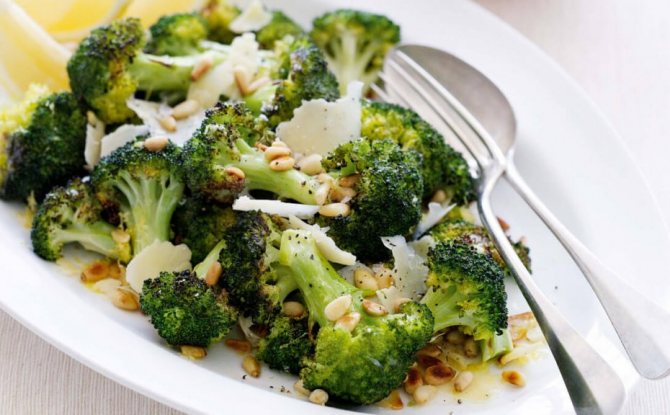
A very simple delicious dish of broccoli with cheese
A very simple delicious dish of broccoli with cheese
Boil or steam the inflorescences for no more than 10 minutes - the cabbage should retain a dark green color. Place the broccoli on a plate and sprinkle grated cheese on top - hard or melted as desired.
Broccoli omelette
First, you need to steam the broccoli for 10 minutes to preserve its rich green color. The cooked broccoli is then placed in a frying pan. Beat eggs into a bowl. Stir and keep on fire until the eggs are cooked. The recipe has a useful feature: when eating the dish, protein is better absorbed, and the body receives additional nutritional components.
Salad with broccoli, shrimp and tomatoes
To prepare the salad you will need: several broccoli florets, 10 cherry tomatoes, 0.5 kg of shrimp, an onion and parsley and dill. To dress the salad you need to prepare 4 tablespoons of olive oil, salt and pepper.
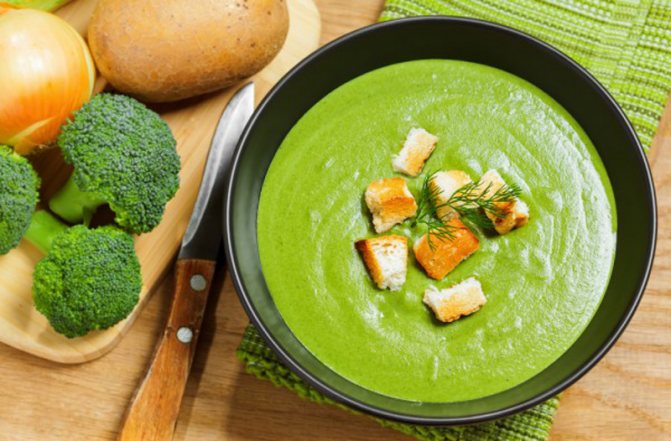
Chicken soup with broccoli added is not only tasty but also a dietary dish
Broccoli should be disassembled into florets and boiled for a few minutes. Also boil and peel the shrimp. Cut the tomatoes into four parts. Peel the onion and chop finely. After everything is prepared, you need to mix all the ingredients, add olive oil, stir and add a little salt and pepper.
Honey, cabbage and yogurt for stomach ulcers
Gastric ulcer is a very unpleasant disease, the causes of which were previously incorrectly determined. In particular, previously, for a long time, it was believed that the cause of stomach ulcers was excessive alcohol consumption, smoking and poor diet.
Stress, depression and addiction to coffee were also considered to be the causes of stomach ulcers. However, as a result of recent medical research, it was determined that 90% of stomach ulcers are caused by the activity of the bacterium Helicobacter Pylori. That is why the most effective and adequate treatment for attacks of peptic ulcer is taking antibiotics. However, during such attacks, it is especially important to follow certain diets in the diet, since antibiotics can kill both harmful bacteria and useful ones, and even those necessary for strengthening the immune system and human health.
The bacteria that cause stomach ulcers can be treated with antibiotics and certain foods. Therefore, it is recommended to enrich the diet of a patient with this disease with products that have bactericidal properties. First of all, such products include honey.
Honey for stomach ulcers
Many people do not know whether it is possible to eat honey if they have a stomach ulcer. Honey has antibacterial properties, which have given this product a reputation as an excellent remedy in the fight against many diseases. In dietary nutrition for stomach ulcers, honey is used in different ways. The amount, time and method of consuming honey is determined by the level of stomach acidity. Read separately about how to find out your stomach acidity. In this regard, it is necessary to use this magical potion carefully, and it is advisable to consult with your doctor regarding the amount of product consumed.
In folk medicine, honey is known as a remedy against stomach ulcers. In this case, it is recommended to eat honey in the morning on an empty stomach, and also before going to bed in the evening. It is recommended to dissolve honey in the amount of a tablespoon in a glass of warm water. This technique will help eliminate the occurrence of heartburn, which is caused by an increased amount of acid.
Cauliflower, white and Brussels sprouts and broccoli for stomach ulcers
In addition to honey, for stomach ulcers, cruciferous vegetables must be introduced into the diet. These vegetables include different types of cabbage - broccoli, cauliflower, cabbage and Brussels sprouts. All these types of cabbage contain a substance called sulforaphane, which effectively destroys Helicobacter Pylori bacteria.
As a result of experiments that were carried out in Europe, the daily intake of any red vegetable for stomach ulcers was determined to be about 60 grams. This is the amount of vegetables eaten daily that can reduce the number of harmful bacteria on the gastric mucosa by 80%.
However, it must be borne in mind that in case of a stomach ulcer, all vegetables consumed must undergo heat treatment. In addition, the use of each type of cabbage should be agreed with your doctor. The extent to which you need to consume sulforaphane with food is determined by the degree of aggressiveness of the gastric environment.
If you have low acidity, then eating white cabbage, as well as cauliflower and broccoli, is tolerated without problems. But if the acidity of the stomach is increased, eating these vegetables will only worsen the situation. In addition, you can try drinking cabbage juice, which is usually well tolerated at any stage of development of a peptic ulcer.
Yogurt for stomach ulcers
For stomach ulcers, a very important food product is yogurt, which contains active cultures. Active cultures are biologically active bacteria such as probiotics, lactic acid streptococci and Bulgarian coli. These bacteria are found in large quantities in live yogurt and suppress the activity of harmful bacteria that cause stomach ulcers. Yogurt also contains bioavailable protein, which, together with beneficial bacteria, effectively heals the surface of the gastric mucosa damaged by ulcers.
zeludok.com
How to drink cabbage juice if you have a stomach ulcer?
Doctors say that adding cabbage to food should take into account the stage of the disease, but cabbage juice, which is able to heal ulcers and relieve pain, has increased benefits and safety for the diseased body. Cabbage juice contains:
- iodine;
- calcium;
- fluorine;
- iron;
- magnesium;
- phosphorus.
In any case, the use of such a seemingly safe product for ulcers should be carried out under the supervision of a doctor.
To prepare cabbage juice, you need to purchase a young vegetable and remove the top leaves that contain harmful pesticides. Cut the cabbage into large pieces and run it through a meat grinder or juicer. For one liter of cabbage juice, you should take two kilograms of the vegetable. The prepared medicinal juice is stored in the refrigerator, but not more than 72 hours.
You should drink cabbage liquid on an empty stomach, on average half an hour before meals. Before drinking the medicine, the juice should be heated to 60 C. This temperature will allow all the benefits of the juice to be restored. The duration of therapy is 30 days. Cabbage juice should be consumed four times a day, 300 milliliters, but provided that the patient does not have complications such as high acidity.
Despite the minimal number of contraindications, cabbage juice is not allowed for pancreatic diseases, kidney diseases and after heart attacks.
Broccoli protects against cancer, ulcers and excess weight
Problems with the gastrointestinal tract radically change a person’s eating behavior. And this is understandable, because when experiencing acute pain, tingling, hot burning, heaviness, tightness in the stomach or constant heartburn, you can not only give up your favorite dishes, but also completely lose your appetite. However, a food boycott can harm the patient even more. Therefore, a clear understanding of how to eat when you have a stomach ulcer will help relieve acute symptoms of the disease and once again feel the joy of life.
Broccoli, its beneficial qualities
The vegetable grows in warm climates. In Russia, broccoli is grown in a number of areas. It appears green in color with elastic stems branching into inflorescences. Fresh cabbage is difficult to store; the product is frozen, which does not deprive the vegetable of its beneficial properties.
Features of broccoli:
- champion in magnesium content, the element is directly involved in metabolism and has a beneficial effect on organs;
- rich in carotene (which is then converted into vitamin A), which functions to restore the gastric mucosa and participates in the healing of damaged tissue, blocking access to infections;
- has an anti-inflammatory effect due to the content of vitamin C;
- contains potassium, which regulates blood pressure;
- The antioxidants contained in the healthy vegetable heal wounds and scars.
It is not recommended to eat broccoli raw. The vegetable is consumed exclusively in stewed, boiled or baked form. The fiber contained in the composition can aggravate the situation and cause vomiting, nausea and other unpleasant consequences. For a similar reason, it is undesirable to use broccoli for gastritis with high acidity.
Radish
This healthy vegetable is allowed for gastritis with low acidity. It not only saturates the body with all the necessary vitamins, but also rids it of pathogenic microflora.
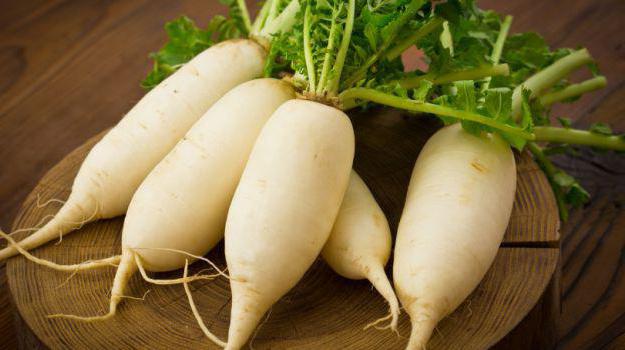
Of course, radish does not cure inflammation itself, but it does promote overall health. It can be consumed both raw and stewed.
Gastritis is a disease that can worsen a person’s quality of life if the diet and recommendations of gastroenterologists are not followed. These factors aggravate the course of the disease, transferring it to the ulcerative stage, which will be much more difficult to cure. Treatment of gastrointestinal diseases is carried out comprehensively using traditional therapy prescribed by a doctor. The process is accompanied by a strict diet at first, with further relaxation. The inclusion of certain vegetables in the menu for gastritis should be reasonable and carried out after consultation with a doctor.

The specificity of the diet for gastritis lies in the fact that, on the one hand, there are several varieties of this disease (erosive and non-erosive gastritis), and on the other, the list of permitted and prohibited foods for all these types is extensive. The question of the benefits of fresh vegetables for gastritis and ulcers is the most pressing among all those available regarding this disease.








